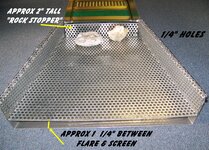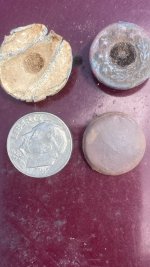Soooooo.... I've got an Angus MacKirk Explorer sluice. I've only been able to using it a couple times in the field, and haven't been that successful with it. However the last time I was out I was just working to locate richer material to run, and I found it. So now I've got a nice pile of gravel to wash that I know has some gold in it. With any luck this weekend I'll get to run it for a few hours. I'm going to try and have it closer to level then last time, and with a slower flow of water. The first time I used it I ran a bucket I thought should have a dozen or more colors, but I only found 2 I think... Anyway.. The point of this post, is to ask about building a punch plate layer to put over the bed of the sluice. If I run punch plate an inch over the riffles for the length of the sluice, will it work as a classifier? Can I safely run enough water down the sluice to use it this way and not blow out smaller gold? Would love to be able to avoid classification.. If so what size holes would I want to have? I think I am currently classifying to 3/8", which sounds about right to me..
You are using an out of date browser. It may not display this or other websites correctly.
You should upgrade or use an alternative browser.
You should upgrade or use an alternative browser.
Punch plate inline classifying
- Thread starter Capricorn
- Start date
Timberdoodle
Sr. Member
I have the explorer and love it. Great sluice and I usually classify to 1/4 and the recovery rate is awesome on fines. I would not recommend a over the top classifier for a multitude of reasons, but the main one is that you will have gold that makes it over a punch plate classifier in this configuration and some that will work down the classifier so far that once dropped into the sluice will have little chance of getting caught like it would if is was fed right from the start. I would recommend building a separate classifier/ wash system if you want to speed up your classification process and take advantage of this sluice working the way it should. Hope this helps.
team sidewinder
Sr. Member
- Apr 14, 2013
- 285
- 78
- Detector(s) used
- MINELAB XTERRA 705 , CTX 3030.
- Primary Interest:
- Metal Detecting
I agree with not using a full sluice length classifier but I have seen ( doubt I can mention the place here ) a classifier that only goes and covers the input flair of the sluice which I think would work better as the material is only classified at the very beginning of the sluice and still lets the entire length of the sluice do its work. I am going to be getting one ( although a person who is handy could make his own and for in your case the Mackirk ) for my Keene A52 sluice before next season.
- Thread starter
- #4
When the punch plate only covers the first bit of the sluice it makes me wonder if it's a good idea. The larger rocks will have to travel over the uncovered portion of the sluice, possibly upsetting the riffle deposits. For now I think I will not worry too much about getting the best classification system, and focus on making sure I am using everything I currently have correctly. At the moment I classify by doing a bucket in bucket method. The inner bucket has 3/8" holes drilled all over the bottom. I shovel rocks and all into 2 buckets and fill them. Then I classify down those 2 buckets into 1 bucket by dumping a little (not enough to clog it) into the bucket with holes. The bucket with holes sits inside a bucket full of water. I twist the bucket with holes around a bit, stir the rocks a bit, and dump it out. It goes relatively quick as it can I think, for having to classify as a separate step.
ALewis
Sr. Member
Why not switch to a fluid bed sluice ? Bazooka Gold Trap, etc....
Seems like they work kind of like you are trying to mod. your Mackirk.
Seems like they work kind of like you are trying to mod. your Mackirk.
ALewis
Sr. Member
Totally understand that side of it... Mine is "Homemade". The real one's seem a little $$$. (Worth it though)
Oh, and hoping to get a Mackirk or Letrap this winter....Have heard great things about both / either. Wanting a light alternative for prospecting
Not trying to knock the Mackirk at all....
Oh, and hoping to get a Mackirk or Letrap this winter....Have heard great things about both / either. Wanting a light alternative for prospecting
Not trying to knock the Mackirk at all....
team sidewinder
Sr. Member
- Apr 14, 2013
- 285
- 78
- Detector(s) used
- MINELAB XTERRA 705 , CTX 3030.
- Primary Interest:
- Metal Detecting

When the punch plate only covers the first bit of the sluice it makes me wonder if it's a good idea. The larger rocks will have to travel over the uncovered portion of the sluice, possibly upsetting the riffle deposits. For now I think I will not worry too much about getting the best classification system, and focus on making sure I am using everything I currently have correctly. At the moment I classify by doing a bucket in bucket method. The inner bucket has 3/8" holes drilled all over the bottom. I shovel rocks and all into 2 buckets and fill them. Then I classify down those 2 buckets into 1 bucket by dumping a little (not enough to clog it) into the bucket with holes. The bucket with holes sits inside a bucket full of water. I twist the bucket with holes around a bit, stir the rocks a bit, and dump it out. It goes relatively quick as it can I think, for having to classify as a separate step.
Yes I do see your point on the large rocks taking out some gold as they tumble down the sluice but I believe the classifier I am looking at probably only has 1/4 inch holes and then does have a shelf at the lower end so larger rocks can be picked off and not enter the sluice. IHMO I don't think any material of 1/4 inch size is going to disrupt your flow enough to take any gold out as they exit the sluice. Also I think it only sits a 1/4 inch off the bottom of the intake flare. My main concern is that this set up may be too restrictive and would require too much hand removing larger material from the classifier but this is all theory on my part as I have not yet purchased this type classifier. I also think I would have to pour water from a 5gal bucket over the material laying in the classifier to get it to wash down into the sluice and I would have to be careful not to pour too much water as to wash out gold laying in the sluice riffles. This is a poor mans high banker of sorts and with the very small amounts of gold we find this about as far as I can go until we find some material with more gold to make investing in equipment to handle more volume.
Last edited:
jcazgoldchaser
Hero Member
- May 8, 2012
- 899
- 515
- Primary Interest:
- All Treasure Hunting
Hoser John
Gold Member
That classifier needs to extend over the first 2 riffles and then you can let them bign's fly right on through. By proper classification, and that punchplate, you've provided all the protection the smaller gold needs to stay in place underneath it. John
- Thread starter
- #12
I like the thread that was linked, thanks. I was thinking about a similar concept, where the washed rocks would go back out the front, I like it. I also like the picture there sidewinder, looks similar to what I was thinking as well.
Top Member Reactions
-
 2352
2352 -
 1127
1127 -
 1051
1051 -
 887
887 -
 824
824 -
 798
798 -
 753
753 -
 753
753 -
 606
606 -
 500
500 -
 490
490 -
 473
473 -
 465
465 -
 423
423 -
 387
387 -
 383
383 -
 381
381 -
 381
381 -
 377
377 -
O
377
Users who are viewing this thread
Total: 2 (members: 0, guests: 2)



